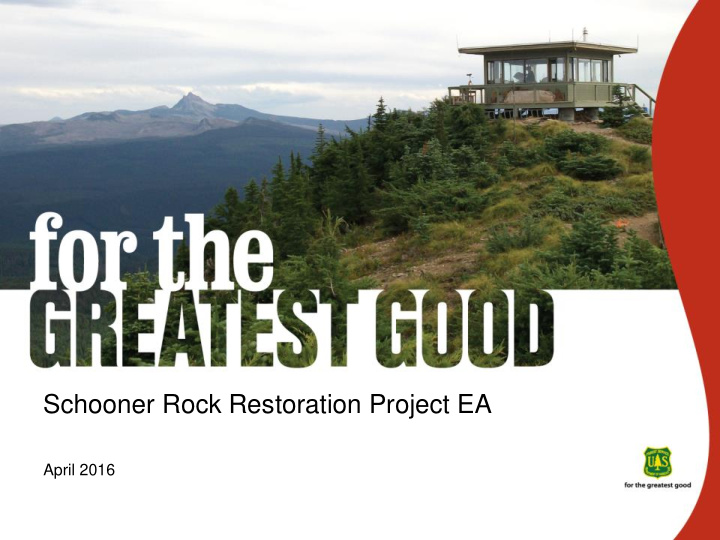



Schooner Rock Restoration Project EA April 2016
Purpose & Need • Need to accelerate the development of late-successional and old-growth forest habitat in young stands located in late-successional and riparian reserves. • Need to improve habitat diversity in young managed stands and to create, maintain, or improve, hardwood tree, and grass, forb, and shrub habitats. • Need to improve the quality of aquatic habitat and meet the Aquatic Conservation Strategy objectives. • Need to sell timber generated from commercial thinning to help fund actions designed to enhance or restore ecosystem function. • Need to maintain or repair forest roads to standards that allow for safe public and commercial use. • Need to use manual, mechanical, and herbicide treatment methods on existing invasive-plant infestations in the Project area; and to implement an early detection-rapid response treatment strategy for newly discovered infestations in the Project area.
Scoping In March 2015, a letter was sent to 160 individuals and organizations. We hosted a public field trip and held additional meetings and field trips with: • State and Local Governments • Oregon State University & Pacific Northwest Research Station • Oregon Wild, AFRC, and User Groups
Results of Scoping The District received 10 comments in response to the scoping letter. General topics included: Thinning prescriptions, gaps & skips, effects of treatment on Riparian Reserves & deadwood, creating early seral habitat, treating invasive species, improving aquatic habitat, economic viability, and public access.
Public Access The initial proposal during scoping included 22 miles of storage/closure and 5 miles decommission. After further internal refinement and discussions with user groups the deciding official modified the proposed action to close roads with hydrologic concerns and to form a partnership with the community to maintain the roads that are remaining open. The proposed action carried forward into analysis includes 5.25 miles of storage/closure and 5 miles decommission. • The partnership will play a key role in determining future use of these roads. If misuse or damage begins to occur they will be closed. • See large map for road details
Public Access Continued… Two roads have unique closures: • 1772 with be a seasonal closure with a gate. It will be closed from March 1 st - September 15 th to account for wildlife concerns and open in the fall winter to allow for recreational use. • Road to Cougar Mtn. Repeater Site will be an admin. closure. Private road easement includes 1,525 feet of new construction on Forest Service land. This easement will replace an easement in the drainage currently causing resource damage.
Vegetation Management Elements Commercially thinning approximately 2,581 acres within 56 previously managed, young conifer stands. • Variable-thinning prescriptions would be prescribed that would leave 40 to 150 trees/acre • Wildlife habitat, stand structure and composition would be further diversified within the treated stands by creating up to 1-acre gaps, planting portions of stands with conifers or hardwoods, and maintaining un-thinned areas (skips) where appropriate. • Provide deadwood habitat for wildlife by creating up to 5 snags/acre and falling and leaving up to 5 trees/acre in commercially-thinned plantations. Additionally, up to three snags per acre would be created in adjacent mature stands by topping live trees to create deadwood habitat for wildlife and promote habitat complexity. • Timber harvest is expected to produce approximately 26 MMBF of timber.
Unique Vegetation Management Elements Active Flying Squirrel Research in the project area • Treating one research plot within a unit • Working with OSU and PNW Research Station Cougar Mountain Repeater Site • Not included in the Forest Plan as a maintenance site • Will remove all merchantable trees in the 6 acre meadow around radio tower 25 acre underburn • Reduce the number of live trees per acre, create numerous snags, and create a mosaic vegetation pattern on the landscape.
Required Road Work Repair and maintain approximately 54 miles of NFS roads in the Project area and use temporary roads to access units. Temporary Roads: • Construct approximately 12 miles of temporary roads on existing templates which would be waterbarred and closed through the timber sale contract at the end of each operating season. • Construct approximately 2.75 miles of new temporary road which would be waterbarred and closed at the end of each operating season. • All temporary roads would be decommissioned following harvest activities.
Unique Vegetation Management Elements Invasive Species Treatment Plan • Treat approximately 295 acres of existing invasive plants in the Project area prior to the start of Project activities. Treatment methods include manual, mechanical, and herbicide. Manual and mechanical treatment would occur on about 249 acres and herbicide treatment would occur on about 46 acres. • Implement an early detection rapid response (EDRR) strategy for managing invasive plants. Following the completion of project activities, monitor known infestations and areas determined to be at high risk of infestation, including system roads, new temporary roads, landings, and areas of ground- based logging operations. A total of 900 acres are estimated to require monitoring.
Hydrology Herbicide spot treatments within the Lincoln City Municipal watershed. • Approximately 25 acres along road ways and 11 acres in plantation units prior to logging activities. An additional 110 acres would be treated as needed after logging and road maintenance activities are completed. Proposing to replace 60 stream culverts and remove and restore the channel on an additional 22 culverts.
What’s Next • The team is currently finishing their analysis and I am compiling the EA. • We expect to initiate the comment period in early May. • Final decision this Fall
Recommend
More recommend